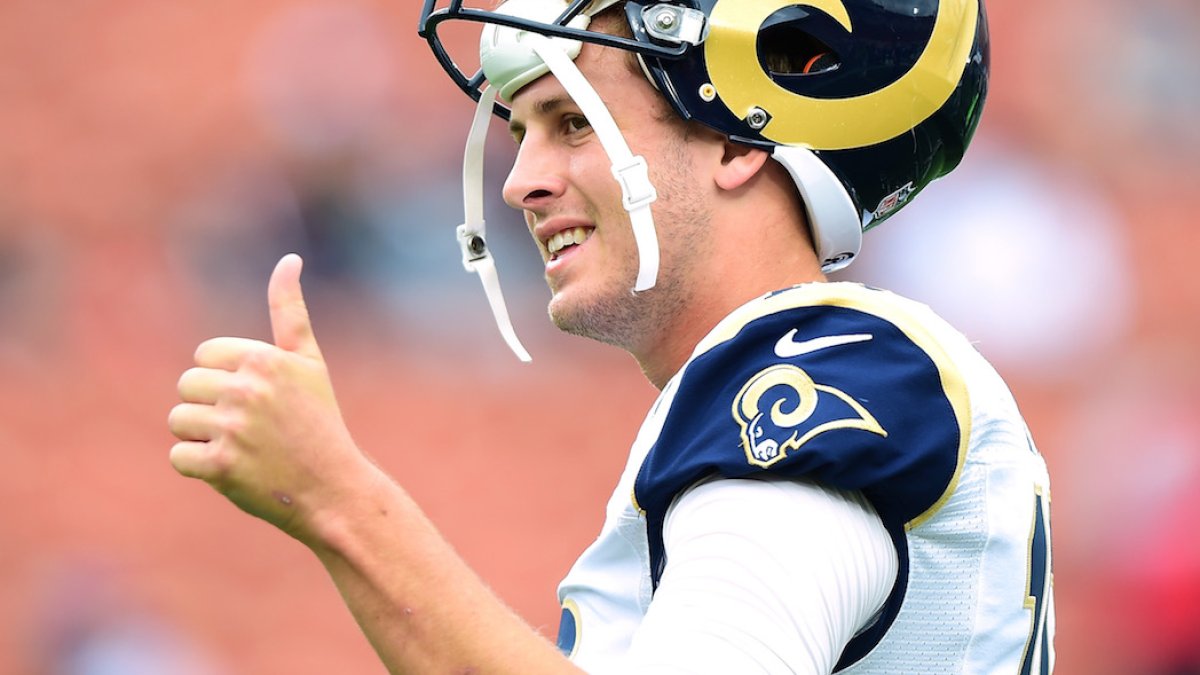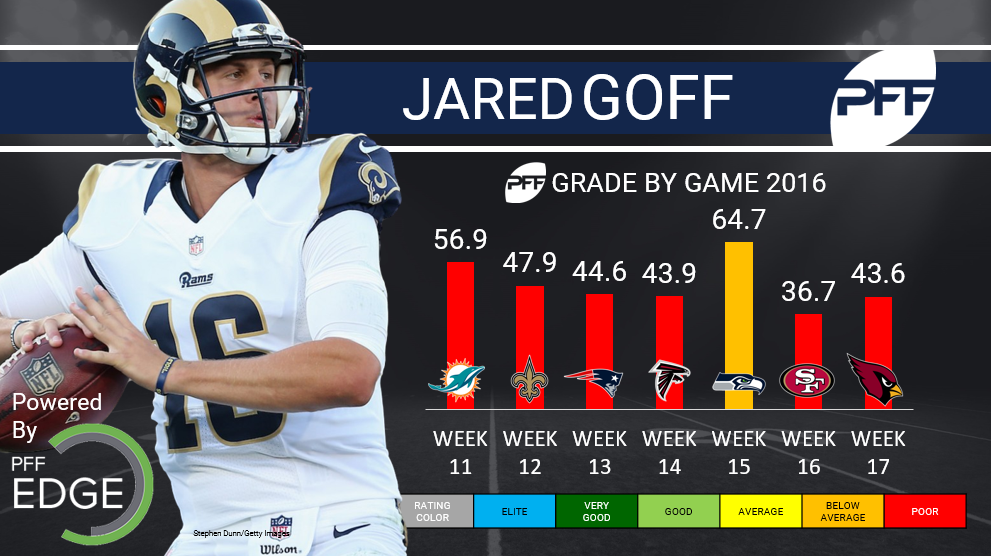The 2016 No. 1 overall pick had one of the worst rookie seasons a quarterback has ever put on display. Sometimes stats can be misleading where the receivers drop would-be touchdowns or unfortunate luck leads to interceptions, but this wasn’t the case for Jared Goff in his debut for the Los Angeles Rams. In fact, his best game statistically — 20 for 32, 214 yards, 3 TDs, 1 INT, 100.3 passer rating — against the New Orleans Saints in Week 12, while showing some promise with some really nice passes in the first half, was marred with a dreadful second-half performance that lost the Rams the game.
Goff’s overall best game by PFF grading came in Week 15 against Seattle, but it was far from a good performance, landing in the “below-average” category with a 64.7. His season progress looks even worse than an overall perspective as he seemingly got worse with more experience following up his best game with an almost historically bad Week 16 game vs San Francisco where he failed to crack 100 yards passing.
So about finding positives…
One area where Goff excelled in college was throwing to the intermediate (10-19 yards in air) and deep (20-plus yards) levels with exceptional accuracy and touch. More specifically, he was best between the numbers in both areas (127.9 passer rating intermediate, 111.1 deep) while also excellent deep right (103.3). His “weakest” area of the field was throwing left, but he was still very good doing so with a passer rating of 90.0 throwing deep left.
Fast forward to the NFL and Goff struggled in his best areas as it’s much more difficult to beat defenses between the numbers. He didn’t complete a pass deep middle and had a passer rating of just 53.3 intermediate middle. Where Goff surprisingly did well was throwing deep left, with a passer rating of 112.5 highlighted by this touchdown against New Orleans.
https://twitter.com/PFF_JohnKosko/status/874999766719098881
Goff wasn’t helped by his supporting cast and offensive line. While he needs to improve with his pocket awareness and recognition of defensive coverages, his offensive line didn’t give him the adequate protection to do so as he was pressured on 44.3 percent of his dropbacks — third-worst in the NFL. In his seven starts, Goff was sacked a league high 26 times with 18 of those being charged to his offensive line. The line’s pass-blocking efficiency of 69.9 was fifth-worst in the NFL during his starts.
Rams receivers also never were able to get on the same page with Goff, and his 7.8 drop rate was second-worst in the NFL. Also not helping Goff was the coaching staff utilizing play action passes more often. Goff attempted play action on just 14.1 percent of his dropbacks despite being a rookie and sporting a passer rating 21.4 points better than no play action — a difference that was actually ninth-best in the NFL. That 14.1 percent PA utilization rate ranked second-lowest in the NFL for the season and his coaches called PA for teammate Case Keenum 20.3 percent of the time, 15th-most in the NFL. To hammer home the lack of PA usage, Goff’s 14.1 percent rate is the second-lowest in the PFF era for a rookie. Rookies play better with misdirection and getting the defense flat-footed, but Goff wasn’t given that advantage nearly enough.
Enter new head coach Sean McVay. McVay called play action at almost 19 percent for Kirk Cousins the past three years in Washington. McVay has done an excellent job tailoring an offensive system for Cousins that resulted in two very good seasons for the former fourth-round pick, including grading as the eighth-best quarterback in the NFL at 85.9 in 2016. McVay will also bring a different run scheme to LA as he ran mostly outside zone and man concepts while LA was primarily and inside zone scheme team in 2016. This should benefit HB Todd Gurley and help open up the passing game.
Also to the benefit of the Rams and Goff, LT Andrew Whitworth is a monster upgrade over Greg Robinson. Whitworth has been arguably the second-most-consistent and best LT in the NFL for the past decade allowing 41 sacks and 31 hits in his 11 year career. Robinson has already passed Whitworth in hits allowed with 33 and is almost halfway to his sack mark with 18 in just three seasons. Also adding center John Sullivan — providing he can stay healthy — should help solidify the o-line.
Goff’s rookie season had a lot of red flags but the situation around him has vastly improved. He didn’t come out of college as a one-year wonder but as a three-year starter in the Pac-12 leading a poor California team to a bowl victory in his final season. He graded extremely well, making numerous big-time throws, but he was thrust into the starting job at the age of 21 when he needed time on the bench to grow into an NFL quarterback.
The second-year QB has said he’s bulked up some this offseason, and the team added veteran Robert Woods as well as drafting WR Cooper Kupp and TE Gerald Everett — two players PFF analysts thought highly of in draft evaluations. The ball is in Goff’s court to utilize the advantages he will have in 2017 to improve. Both Derek Carr and Blake Bortles made major improvements from year 1 to year 2, and Goff has the talent and ability to do the same, even if he doesn’t have the same caliber of weapons those two enjoyed.





 © 2024 PFF - all rights reserved.
© 2024 PFF - all rights reserved.